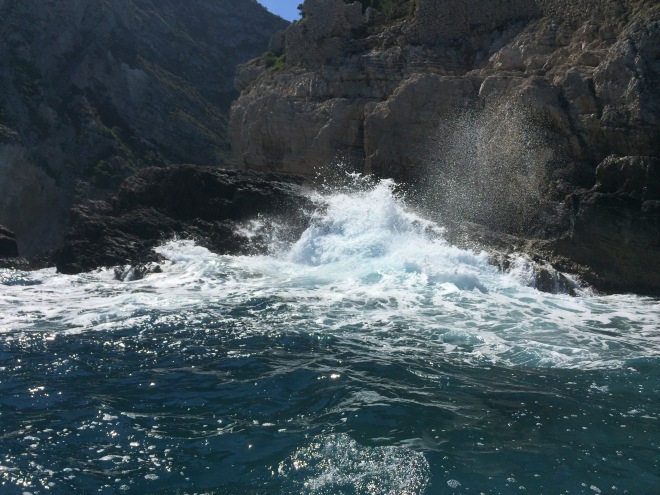Swimming, absolutely love it! The feeling of gliding freely through the water is second to none.
The soothing myriad of blue shades ranging from intense turquoise hues to almost paler shades of grey caress the worlds’ coasts over and over again.
However, water the basic life force flowing through the world’s oceans, seas, rivers and streams has many sides to its character. It is transparent and opaque at the same time. It can be refreshing and clarify your thoughts or distort the vision before you.
One minute the beauty of it can portray an image of peace and tranquillity and serenity and the next can transform into a raging beast, ready to destroy everything in its path. When it stagnates for long periods of time, it brings disease and death with it.
In fog form, water can creep through crevices as mist, terrifying even the brave and fearless, mysteriously enveloping everything around it. An atmosphere of both sadness and exhilaration can be created when it rains. It has even been claimed that the invigorating benefits of water can bring about youth and vitality. Yet this substance is something that we cannot live without. Without water there would no life on earth.
Our assessment systems are currently in a state of stagnation. Without accurate assessment systems in place, we cannot create a culture of helping each child achieve their potential.
Without water, we would not exist. So therefore, we must learn to conquer it, in other words learn how to swim.
We need to learn how to conquer the complexities of accurate assessment in order to support our pupils ride the waves of success.
This got me thinking about how to assess accurately beyond levels. We need to have a set of agreed questions within the teaching profession which would distinguish between secure and mastery at each year group for each subject. With war being declared on primary writing moderation, the need has become even more urgent. It still sounds like levels but it is the only way forward. How can we teach and ensure progression without it? Just as humans needing water for survival, so do pupils need to be accurately assessed.
One idea is to use Bloom’s Taxonomy to create the questions.
I wrote a history assessment without levels a few years ago for primary.
Could we base all assessments on similar criteria? What is clear is that collaboration will be key in ensuring the successful implementation of assessment without levels.
For the last two weeks I have been taking my Year 5s swimming every day. We decided that it was better to have an intensive swimming course for one hour per day, over two weeks rather than spread it out over 10 weeks. When children attend swimming lessons once per week over a period of time, progress can be quite slow.
Having never taken children swimming before ( apart from my own), it was indeed a revelation. I had completely forgotten how shy and embarrassed they are at this age and how they can even laugh at their own embarrassment.
My class are an extremely enthusiastic bunch and their excitement about swimming penetrated my soul. Meet some members of my class:
Pupil 1- he is ultra confident, has been accustomed to the high life, wants the very best in life, always wants to be the best at everything but avoids hard work
Pupil 2- came to the UK last year and has too much confidence, tries to make up for the fact that his mother has left his father behind in another country
Pupil 3- has global delay, doesn’t retain information, tries hard
Pupil 4-comes from an extremely large family, had constantly been told that he was not good enough, wants opportunities in life but sometimes can’t access due to lack of parental support
Pupils 5 and 6- EAL and new to the country and school, nurtured by parents
Pupil 7- EAL, never been to school before coming to England which was a couple of months ago
Pupil 8- shy, not very confident
The first day was assessment day so they did not really spend much time swimming. It was more about getting into routine and understanding rules and regulations. Their groups had been decided based on how confident they had been in the water.

To the untrained eye the children were just splashing around apart from three who could really swim.
To the trained eye, there were three groups of children: the swimmers, the quick learners and the slower learners: learners they all were but to varying degrees.
The following day they were all separated into three groups and began on this special learning journey. The three excellent swimmers were challenged to swim the whole length and other various challenges were added in. They also had to work on their stamina.
It wasn’t a surprise that Pupil 1 was not in this group. During class it quickly became obvious that this pupil did not enjoy challenging himself. He was afraid of hard work and very reluctant to try new things. I wondered how and why a quite intelligent boy would end up like this.
Maybe he has been praised for intelligence but not effort. It is obvious that he has been spoilt. Most of us do spoil our own children but have to be mindful to teach them valuable lessons to ensure a successful life.
The second group were taught activities to accelerate floating and moving in the water.
The third group, who were extremely afraid if the water, needed their confidence to be built up.
The second group surprised me the most. On the second day, they started swimming. This was no ordinary swimming, they were streamlined and swam elegantly through the water, like they belonged in it. They looked as though they had conquered the water.
The third day the second group were taught how to breath under water. By the fourth day they were swimming several metre lengths ranging from 2m to 12m. Pupils 2, 4, 5 and 6 were in this group.
Accurate assessment is as important as the sir we breath. I still don’t know how the swimming instructors assessed the children so accurately to know which children would be focused and well motivated enough to learn. I was surprised by their choice of putting Pupils 2 and 4, who normally find it difficult to focus on class, into the second swimming group.
They were completely focused and determined to learn how to swim. Their motivation became infectious as their whole group remained focus and resistant to distractions, listened intently to instructions and followed them correctly.
However, when I am out of class these two boys suddenly switch into completely different children and display the emotional turmoil that their background is really having on them. This, I find the saddest part of my job.
This got me thinking more deeply about assessment and accountability. In the classroom we use formative assessment to help pupils make immediate progress through teacher questioning.
The time has come for teachers to collaborate and agree on probing questions for both formative and summative assessment. This will require and deep understanding of subject knowledge and pedagogy.
Back to swimming for a minute. The third group found it extremely difficult to concentrate and were easily distracted. They had been assessed accurately and they were given extra support to succeed. The group were further divided in the second week into those who were not going to learn to float and those who would.
A sadness filled my heart when I saw that Pupil 1 was in group 4. Pupil 7 who had never been to school was in group 3 and was doing quite well at floating and managed to swim a couple of metres. Pupil 1 became ‘sick’ on the second day and refused to swim. I was devastated.
Although, he is slowly beginning to challenge himself in the classroom, and reluctantly trying new activities, I wondered how long he would keep this up. I got the feeling that he led a somewhat sheltered life and I really felt for him.
Thankfully and to my relief the next day he was back in the water and making some effort. I have been speaking to his parents all year about allowing him to try new activities and challenges but they are rather overprotective of him and my advice seems to fall on deaf ears.
Pupil 3 loved swimming from the minute his toes touched the water. I have never seen anyone throw themselves into the water like he did. It was a lovely surprise that he did so.
I could see and feel the pride swelling up inside of him and I felt a flutter of butterflies in my stomach. The difference between Pupils 1 and 3 were that Pupil 1 had already given up before he had started and did not enjoy challenges but Pupil 3 was determined and worked really hard.
I could already see the resilience in Pupil 3 in the classroom but was unaware about how this would translate into other areas of learning. Clearly it does. This was Growth Mindset in motion and what a beautiful thing it was to see.
Pupil 8 also surprised me. I had watched her try to swim for about 7 days with little success, so I decided to have a pep talk with the group who were struggling to swim. I explained that they had to work hard in order to learn how to swim. They had to use muscles that had been unused before but in addition to this they had to become fearless of the water. They had been taught how to blow bubbles in the water and need not worry about drowning. If they overcame this fear, then with hard work they would be able to swim. Above all they had to believe in themselves in order to succeed ( had shared stories about self belief all year).
Out of the whole group, I suddenly saw Pupil 8 pushing herself in the water and I witnessed the determination in her face for the first time. The self belief shone through like a ray of sunshine, culminating in muscles being forced to awaken and move against the resistance of the water.
I have referred to self belief as a ‘golden thread flowing through our arteries’ in a previous blog and could visualise this. I felt extremely proud that we had achieved one more swimmer between us. After getting dressed Pupil 8 came out of the changing room, walked over to me and said ‘Thank you for making me believe in myself. Now I can swim.’ I could have cried.
Out of 24 children, 3 children could swim already and 4 never reached water confidence during the two weeks we had swimming lessons. Seventeen children learnt to swim in two weeks. Now that is progress!




